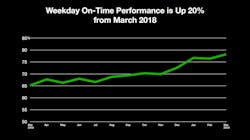Subway Performance Continues to Show Dramatic Improvements, Reaching Highest Weekday On-Time Performance in Five Years
Metropolitan Transportation Authority Chairman and CEO Patrick Foye, Managing Director Veronique Hakim and NYC Transit President Andy Byford announced new statistics showing the continued dramatic subway performance improvements that have been achieved since the launch of the Subway Action Plan and the Save Safe Seconds campaign.
On-Time Performance continues to be significantly improved over 2018, and major incidents are declining steadily, while customer-based performance numbers are also pointing higher, and track fires have significantly decreased. MTA officials today said that these results show the Subway Action Plan and NYCT’s Save Safe Seconds “back-to-basics” approach are continuing to pay dividends for riders across the system.
The improved performance statistics are being felt by subway customers. The latest quarterly customer survey results to be reported in next week’s Transit Committee meeting at MTA headquarters will show that subway customers say they are seeing positive changes, with improvement in overall service ratings.
The Subway Action Plan was launched at the direction of Governor Andrew Cuomo in July 2017, and funded by the governor, legislature and city, with the goal of taking extraordinary measures to stabilize and improve the more than 100-year old subway system.
“These latest performance results are another reminder that investment in the system, and smart operations by dedicated, hard-working professionals, yield real, tangible results,” said MTA Chairman Patrick Foye. “They’re also an assurance that the additional funding we’ll be getting through central business district tolling will be money well spent – we’re showing the potential our team has, and a huge new capital boost will only drive performance up even further.”
“We have a long way to go, but getting back to the basics of both maintenance and operations through the Subway Action Plan and Save Safe Seconds campaign is bringing the subway up to a much better baseline from which to modernize the system,” said NYCT President Andy Byford. “We are working to squeeze every drop of performance we can out of this system and the funds promised by central business district tolling will ultimately allow us to deliver the service that New Yorkers need and deserve.”
Weekday On-Time Performance (OTP) for March was approximately 78.2%, a significant increase from 65.2% in March 2018, and the highest OTP since November 2013. MTA officials noted that Weekday Major Incidents totaled 50 for the month of March, down 40% from 84 in March 2018. Weekday Delays in March were 37,667, a reduction of 40% from March 2018. This reduction meets President Andy Byford’s recently announced goal of reducing average monthly delays by 18,000; the previous goal was 10,000.
Positive numbers were also realized in many of NYCT’s customer-focused metrics, including Service Delivered, Additional Platform Time, Additional Train Time, and Customer Journey Time Performance. All trended higher than March 2018 and higher than their 12-month averages. Most notably, Additional Train Time – the average additional unanticipated time customers spend onboard the train due to various service issues – dropped 27% from March of last year. Customer Journey Time Performance for March was 82.9%, an increase from 79.3% last March.
A contributing factor to the reduction in delays has been the significant progress made in reducing track debris fires, which are significantly down since NYCT started attacking this problem with new equipment in 2017. This has included clearing debris at an unprecedented rate using new platform-based mobile vacs, and vacuum trains that move around the system picking up trash. Year to date this year, track debris fires dropped 42% compared to 2018, from 111 to 64, and over the last 12 months, track debris fires dropped 34% from the prior 12 months, from 444 to 294.
Since the mobile vacuum effort began in 2017, mobile vacuum crews have removed 350,000 bags of dirt and trash weighing over 8.75 million pounds by heavy scraping and cleaning. Furthermore, the overall effort to improve track cleaning resulted in increase of trash and debris collection from 11.4 million pounds in 2016 to an average of 15.5 million pounds per year since then. The effort has included cleaning of all 418 miles of underground subway track by the end of 2018.
Overall service satisfaction, obtained by asking customers to evaluate individual subway lines and then weighting the results by ridership, increased by 6.1 percentage points to 61.4% this quarter. More detailed results from the quarterly “Customer Counts” survey will be available in the Transit Committee report to the MTA Board later this month.



